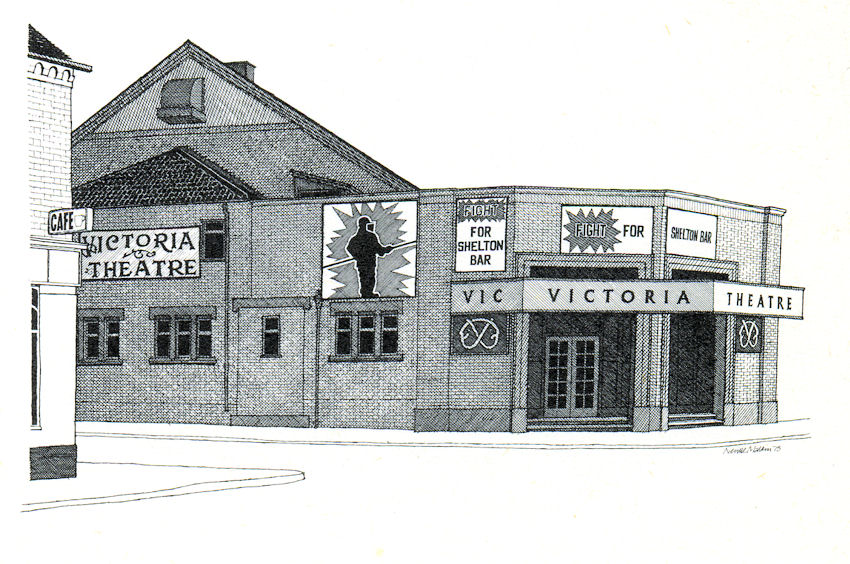|
|
|
![]() back to "The Grand Tour" index
back to "The Grand Tour" index
Neville Malkin's "Grand Tour" of the Potteries
buildings South of the Potteries
![]()
![]()
![]()
next: City General
Hospital, Newcastle
previous: Holy Trinity
Church, Hartshill
contents: index of
buildings south of the Potteries
|
No 19 - Victoria Theatre, Hartshill - now moved location - "A permanent North Staffordshire home was planned. On 9 October 1962, a converted cinema opened its doors as a theatre, an event that received no mention in the national press. The company moved to a new, purpose-built theatre, The New Vic, in 1986. Under the leadership of founding
Director, Peter Cheeseman, the company became known for documentary drama
with productions such as The Fight For Shelton Bar and Jolly Potters
reflecting the preoccupations of and the issues affecting the communities
of North Staffordshire, with its economy based on ceramics, coal and
steel." |

Victoria Theatre, Hartshill
pen drawing by Neville Malkin - Feb 1975
|
"The Victoria Theatre, Hartshill, is North Staffordshire's only professional repertory theatre, and Britain's only permanent professional Theatre in the Round. The building was originally built as a picture house in 1914; in the late 1950s it became a nightclub and, finally, in 1962 was acquired and converted to its present form at a cost of £5,000. It opened its doors as a theatre on October 9th, 1962. This drawing of the theatre was done at a time when the men of Shelton Bar found their livelihood in jeopardy due to the threatened closure of the steelworks. The men decided on action and asked the Victoria Theatre Company to present a documentary on the subject and so publicise their cause; the result was Fight for Shelton Bar, the seventh of the Vic's musical documentaries. The fact that so many of the Vic's plays are based on local material has given the theatre an international reputation as a community theatre; although most of the audience come from the immediate vicinity, it also attracts substantial numbers from all over Britain, and beyond. There are about 300 performances of plays each year, half of which are especially written for the Vic. Authors of new plays have included Alan Ayckbourn, Arthur Berry, David Campton, Ken Campbell, David Haliwell, Alan Plater, Peter Terson, John Wain and many others. Many television and theatre playwrights and dozens of familiar faces began their careers at the Vic. The Vic itself has been the subject of four television documentaries, and the Artistic Director, Peter Cheeseman, and the company have created four major television dramas, all based on North Staffordshire. In the Vic's first season the average audience was 27%; this figure has increased steadily until today it is about 70%. The Vic has established not only its theatrical reputation but also its place in the community. A survey taken some time ago showed that one local person in six had been to the theatre, and that 60% were under 25. Negotiations are continuing to find a suitable site in the Potteries for a new purpose-built Theatre in the Round."
|

Britannia Building Society,
Hartshill - March 2009
The company moved to a new,
purpose-built theatre, The New Vic, in 1986.
|
The Victoria Theatre Company was the first professional company in Britain to perform permanently in the round - that is, with the audience on all sides of the acting area. Today, the New Vic is known both for its professional productions and for its award-winning work in the community. The company’s origins go back to the late Stephen Joseph, director, actor, designer, lecturer and writer. In the late 1950’s, along with other younger theatre practitioners, he was ambitious to renew the vitality of British theatre, founding the Studio Theatre Company to explore a new layout for performance: theatre-in-the-round. The company’s first base was Scarborough from which it toured the country taking the ‘theatre’ with it - raked platforms providing in-the-round seating for 250. Newcastle-under-Lyme was visited regularly and a permanent North Staffordshire home was planned. On 9 October 1962, a converted cinema opened its doors as a theatre, an event that received no mention in the national press. The company moved to a new, purpose-built theatre, The New Vic, in 1986. Under the leadership of founding Director, Peter Cheeseman, the company became known for documentary drama with productions such as The Fight For Shelton Bar and Jolly Potters reflecting the preoccupations of and the issues affecting the communities of North Staffordshire, with its economy based on ceramics, coal and steel. 1n 1998, Peter Cheeseman was succeeded as Artistic Director by Gwenda Hughes who has worked extensively in British theatre as an actor and director. For ten years, she was Associate Director with Birmingham Rep and has directed award-winning work in London’s West End. Following her appointment, the New Vic has adopted an increasingly outward-looking and collaborative approach to the communities it serves, seeking to re-define the ways a theatre can contribute to the cultural, educational, social, recreational and economic lives of the communities it serves. This has led to the setting up of an Education Department to work within formal education, and the company’s ground-breaking outreach department, New Vic Borderlines, which concentrates on work that encourages, enables and promotes Social Inclusion, Community Cohesion and Neighbourhood Renewal. Today, the Education and Borderlines departments are responsible for one third of the company’s work. Central to the company’s ethos is the belief that each aspect of its work is of equal value. The language of ‘audiences’ has given way to one of ‘engagement’. A young person devising a piece of theatre with Borderlines, the audience for a Shakespeare play, or a class of primary school children working on reading skills are all engaged with the New Vic and all are of equal importance. The New Vic continues to address issues of concern to people locally. It believes in the power of theatre to change lives for the better. It believes that everyone has creative and artistic abilities and that, through encouragement, participation and example, they can be enabled to fulfil their creative potential. In January 2007, Gwenda Hughes stepped down and Theresa Heskins became the company's third Artistic Director. From the New Vic web site
|
next: City General Hospital, Newcastle
previous: Holy Trinity Church, Hartshill
contents: index of buildings south of the Potteries
back to "The Grand Tour" index